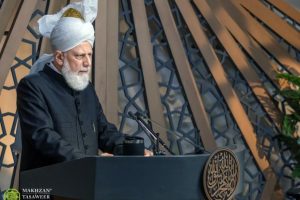
Munavara Ghauri, UK
Editor, Women’s Section
This year is a momentous one for the women of Lajna Ima’illah, the women’s auxiliary organisation of the Ahmadiyya Muslim Community, as they celebrate their centenary. It has been 100 years since the Second Caliph and Worldwide Head of the Community, His Holiness Mirza Bashiruddin Mahmud Ahmad (ra), established Lajna Ima’illah. He understood the pivotal role of women in society and realised that it is primarily women who shape future generations. Hence, he foresaw the need for them to be educated in both spiritual and secular terms.
As part of the Lajna Pledge, members declare a willingness to sacrifice their ‘property’ ‘for the cause of faith and nation.’[1] The financial sacrifices of Lajna Ima’illah have been truly outstanding over the past 100 years and show no signs of abating as these women continue to give.
The Holy Qur’an is full of guidance for believers to spend in the way of Allah for their own benefit as well as that of others. In chapter 2 of the Holy Qur’an, Allah Almighty states:
‘…And whatever of wealth you spend, the benefit of it will be for yourselves, for you spend not but to seek the favour of Allah. And whatever of wealth you spend, it shall be paid back to you in full and you shall not be wronged.’ [2]
It is a concept that the members of Lajna Ima’illah have long understood. If we look at the pioneers of this organisation, we see that Syeda Nusrat Jahan Begum (ra), the wife of the Founder of the Ahmadiyya Muslim Community – the Promised Messiah, Mirza Ghulam Ahmad (as), was at the forefront of financial sacrifices. In 1900, the Promised Messiah (as) wished to build a white minaret in his hometown of Qadian, India – the then Headquarters of the Ahmadiyya Muslim Community – to fulfil a prophecy of the Holy Prophet (sa). He asked the Community members to raise 10,000 rupees for the project and expressed that if 100 members of the Community each donated 100 rupees, the project would be possible. His wife, Syeda Nusrat Jahan Begum (ra), acted immediately. She sold some property she had inherited in Delhi and then contributed 1,000 rupees for the construction of the minaret, thus donating one tenth of the entire cost.[3]
This was not just a one-off sacrifice but a habit of a lifetime. In the same spirit, her daughter-in-law, Syeda Mahmooda Begum (ra), the first President of Lajna Ima’illah, would make great sacrifices throughout her life. One such financial sacrifice was recognised by the Second Caliph, His Holiness, Mirza Bashiruddin Mahmud Ahmadra, also the husband of Syeda Mahmooda Begum (ra). His Holiness (ra) appealed to the Community in 1913 for funds to help start a Community newspaper. Consequently, Syeda Mahmooda Begum (ra) donated 2 pairs of gold bangles for the project, although she had been saving one pair for their daughter, Nasira Begum. Thus, the Al Fazl newspaper, enjoyed even today by members of the Ahmadiyya Muslim Community worldwide, became a reality through the sacrifices of a devout Lajna.
Regarding this sacrifice of his wife, His Holiness, Mirza Bashiruddin Mahmud Ahmad (ra), paid tribute to her in the very same newspaper in 1924. In very powerful and emotive words he said:
“As God had incited Hazrat Khadija (may God be pleased with her) to help the Holy Prophet (peace and blessings of God be upon him) in the same way, He incited my wife to my help. She knew full well that to invest money in a newspaper, specially one brought out by Mahmud…was equivalent to throwing money in a ditch…this one kind gesture of hers is enough to overwhelm me. Her generosity as it were, gave me hands to serve the religion…How true is this saying, ‘A woman is a quiet worker.’”[4]
Another wife of His Holiness Mirza Bashiruddin Mahmud Ahmad (ra), Syeda Maryam (ra), also lived a remarkable life of sacrifice and dedication to her faith. Her niece was to recollect of her aunt’s incredible capacity for sacrifice:
‘She had set allowances for various widows from her own pocket; she spent on the education of many orphans in a way that no one got the wind of it. It was not in her nature to exhibit such charity. Under no circumstances could she tolerate to advertise such good deeds. It was her daily practice to give charity, but then there would come a month in the year when she would give away everything she had, for the sake of Allah, and that was the month of Ramadan.’[5]
The sacrifices of Lajna Ima’illah are not now limited to one family, era or nation. Their sacrifices have proliferated with alacrity and pace across the globe. By way of example, their tangible sacrifices can now be witnessed in the bricks and mortar of many beautiful mosques worldwide. The Fazl Mosque, in Southfields, London, was funded by Lajna and inaugurated in 1926. It was the first purpose-built mosque in the capital. The Mubarak Mosque in the Hague, Holland, was built in 1955 with Lajna funds. So was the uniquely shaped Nusrat Jahan Mosque of Copenhagen, Denmark, in 1967.[6] Furthermore, two dedicated Lajna, Al-Hajia Fatima Ali and Al-Hajia Ilarga, funded two mosques in Ajaybovaday, Lagos, Nigeria.[7]
More recently, the sacrifices of Lajna members are recounted by the Fifth Caliph and Worldwide Head of the Ahmadiyya Muslim Community, His Holiness, Mirza Masroor Ahmad (aba), on a regular basis. Speaking in a Friday Sermon of November 2022, when His Holiness (aba) related the financial sacrifices of Ahmadi Muslims for the scheme known as Tehrike-Jadid within the Community, used to fund mosques, mission houses and clinics[8], His Holinessaba mentioned how an inspiring new convert to Lajna Ima’illah in The Gambia, Sister Fato, was willing to give up 200 dalasi for this fund. This was not extra money that she enjoyed, but essential money with which she had intended to buy food. However, she felt the propagation of Islam to be a far greater cause as she said:
’I am doing so as there is a need for it for the propagation of Islam. I shall sacrifice by going hungry…’[9]
Meanwhile, as she uttered these faith-filled words, her son from Switzerland called her, although he had not done so for 6 months. He told his mother that he had sent her 12,200 dalasi. Sister Fato was overwhelmed with gratitude to Allah Almighty and then pledged to sacrifice even more for the cause of her faith.[10]
My sisters in Lajna Ima’illah will know that whilst such incidents are truly inspiring, they are far from exceptional in our organisation. Lajna Ima’illah which translates as the ‘Organisation of the Servants of Allah’ are indeed just that, women dedicated to the service of their Creator, Allah Almighty. They are women who sacrifice and in doing so they follow the excellent example of the Holy Prophet of Islam (sa). The Holy Prophet (sa) has been acknowledged as the most influential person in history[11] and yet he left this world with nothing. His wife, Aisha (ra), related that when he passed away, the Holy Prophet (sa) left neither a dinar nor a dirhem, neither a goat nor a camel, nor a will to bequeath anything.[12]
It is this remarkable spirit of sacrifice that the women of Lajna Ima’illah follow today and will continue to do so as the next exciting chapter of their history unfolds.
About the Author: Munavara Ghauri BA (Hons) Eng Lit, is married with 3 children and works as a School Librarian and in a Women’s Refuge. She is currently serving as the Branch Leader for the Bournemouth Women’s Auxiliary Organization of the Ahmadiyya Muslim Community and is an Editor for the Women’s Section of The Review of Religions.
ENDNOTES
[1] The Constitution of The Lajna Imaillah, Silsila ‘Aliya Ahmadiyya 2017, Lajna Section Central, UK, opening page.
[2] Holy Qur’an, Edited Malik Ghulam Farid, Islam International Publications Ltd, 1988, Ch2-V273
[3] Prof Syeda Naseem Syed, Sirat o Sawanneh Hazrat Amma Jan, Lajna Imaillah Lahore, 2005, p.474
[4] Al Fazl 1924, p.4, taken from ‘Lajna Speaks Souvenir 50th Anniversary’ magazine, Central Lajna Imaillah, 1972, p.29
[5] English translation of Urdu book, Tabaeen Ashab e Ahmad by Hazrat Malik Sallahuddin Sahib, 1979, Vol. III, Seerat Hazrat Sayyeda Umme Tahir, pp.168-169
[6] Nur-ud-Din Muneer, Ahmadi Muslims, Historical Outline, Nur-ud-Din Muneer, 1983, (XV)
[7] ‘Lajna Speaks Souvenir 50th Anniversary’ magazine, Central Lajna Imaillah, 1972, p.57
[8] https://www.alislam.org/friday-sermon/2012-11-09.html
[9] https://www.alhakam.org/friday-sermon-blessings-of-financial-sacrifice-tahrik-e-jadid-new-year-2022-4-november-2022/
[10] ibid
[11] https://www.biographyonline.net/people/100-most-influential.html
[12] Sunan Ibn Majah, Kitabul Wasaya, Bab hal ausa Rasulullah, taken from Dr K Zirvi, The Holy Prophet of Islam, Hadrat Muhammad Mustafa, KZ Publications, 2009, p.428




Add Comment